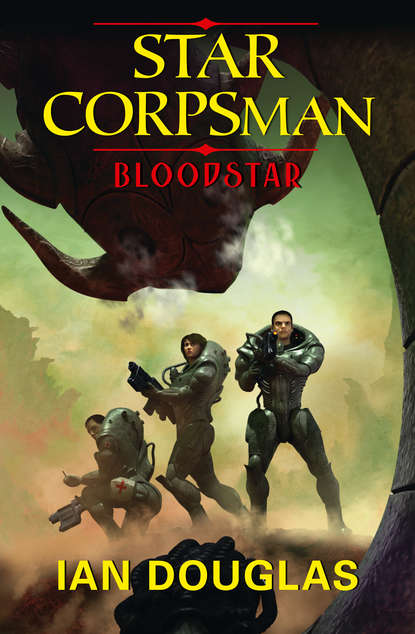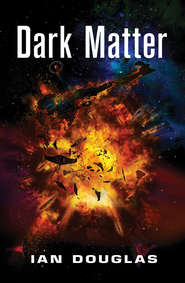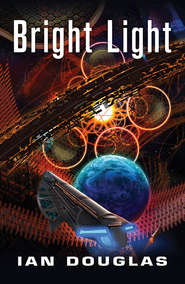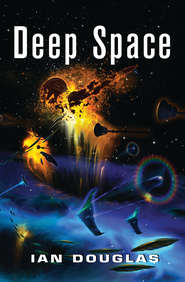По всем вопросам обращайтесь на: info@litportal.ru
(©) 2003-2024.
✖
Bloodstar
Настройки чтения
Размер шрифта
Высота строк
Поля
I knelt beside him and felt for a pulse. Faster than two a second, and pounding.
The fastest way to derail convulsions is a shot of nano programmed to hit the brain’s limbic system and decouple the spasmodic neuronic output, a nanoneural suppression, or NNS. That’s the way we treat epileptic seizures. The trouble was, this wasn’t necessarily epilepsy, and messing with the brain, outside of relatively straightforward pain control, is not business as usual for a Corpsman.
I opened an in-head CDF channel. “Dr. Francis? I need you up here. B Deck, berthing compartment eleven two.”
“Already on my way, Carlyle. What do we have?”
“Twenty-year-old male in convulsions. Elevated heart and BP.” I hesitated. “He was at sick call this morning with symptoms of the flu.”
“Go ahead and initiate an NNS.”
“Aye, aye, sir.”
I pulled a spray injector from my kit and clicked in a plastic capsule of gray liquid, held the tip against Howell’s carotid, and fired it into his bloodstream. Elsewhere in my kit was an N-prog, a handheld device that used magnetic induction to program nanobots after they were inside the body. I switched it on and glanced at the screen.
What the hell? The device was picking up easily twice the dosage of ’bots, and they were already running a program. Not only that, they were recruiting the new ’bots, passing on their programming as the new ’bots flooded into Howell’s brain. On-screen, I could see a graphic representation of the nanotech war going on inside his brain—a haze of red dots and gray dots, with more and more of the gray switching to red as I watched.
And the seizures became more violent, horrifically so. Howell’s back arched so sharply, his hips thrust forward, I was afraid his spine was going to snap. With each thrust, he gave another bellow. The muscles were standing out on his neck like steel bars, his mouth wide open, and blood was streaming from his nose. This was not good. If I didn’t get the convulsions under control soon, he would have a massive stroke or a heart attack on the spot.
I punched in my code, then entered Program 9, holding the N-prog close to the side of his head. The remaining gray dots turned green and, slowly, slowly, the red dots began switching to green as well.
“C’mon! C’mon!” I breathed, watching the slow change in colors. Green ’bots meant they’d accepted the new program, which would guide them through the brain tissues to the limbic system and to the motor-control areas and the cerebellum, where they should start damping out the neural storm that was wracking Howell’s brain.
Damn it. I wanted to call it epilepsy, but it wasn’t, though it showed some of the same signs and symptoms. It looked as though Howell’s limbic system had just started firing off high-energy signals. The red nano was behind it, I suspected. Somehow, they appeared to be programmed to enter the limbic system and stimulate the neuron firings that had resulted in Howell’s bizarre seizure. I could see that the red ’bots were clustered in several particular spots deep within Howell’s brain—a region called the ventral tegemental area, or VTA, and another called the substantia nigra. I didn’t know what that meant; Corpsmen are given basic familiarization in brain anatomy, of course, but detailed brain chemistry is definitely a subject for specialists and expert AIs.
I needed to know what was going on in there chemically. I tapped out a new program code, setting it to affect just ten percent of the nanobots I’d just put into Howell’s brain.
Interstitial fluid—the liquid that fills the spaces between the body’s cells—is a witches’ brew of water filled with salts, amino acids and peptides, sugars, fatty acids, coenzymes, hormones, neurotransmitters, and waste products dumped by the cells. It’s not the same as blood or blood plasma; red cells, platelets, and plasma proteins can’t pass through the capillary walls, though certain kinds of white blood cells can squeeze through to fight infection. The exact composition depends on where in the body you’re measuring, but with nerve cells the interstitial fluid is where the chemical exchange takes place across a synapse, the gap between one nerve cell and another. I was telling the ’bots to begin directly sampling the mix of complex molecules floating among Howell’s neurons.
The answer came back as a long scrolling list of substances, but one formula by far outweighed all of the others: C
H
NO
. I had to look it up in my in-head reference library, and when I saw what it was I could have kicked myself.
Dopamine.
About then is when Dr. Francis arrived. “Make a hole!” one of the Marines barked, and the cluster of people around me and Howell scattered apart. I handed him my N-prog with the formula still showing on the screen.
“Shit,” was all he said when he read it.
Using my N-prog, he took over the programming of the nanobots, checking the progress of Program 9 first. There were definitely fewer of the red specks now, and a lot more of the green. In addition, some had switched over to orange, the ’bots engaged in sampling Howell’s cranial interstitial fluid.
The nanoneural suppression routine appeared to be working, once the green ’bots got a substantial upper hand over the red ’bots in numbers. Howell’s back was still arched, the muscular contractions were continuing, but they were decidedly weaker now, and expressing themselves as a long, steady quiver rather than the violent thrusting motions of a moment ago.
Dr. Francis was tapping in a new program code. “Neuroleptic intervention at the D2 receptors,” he told me. “It blocks dopamine.”
The ’bots clustered in Howell’s VTA were almost all green now, and the effect was spreading out through the motor region of his cerebral cortex and his cerebellum as well. The motor cortex is what plans and controls voluntary motor functions of the body—muscular movements, in other words. The cerebellum is the part of the brain at the very back and bottom of the organ that regulates the body’s muscular movements. It doesn’t initiate them, but it does help control them to fine-tune motor activity, timing, and coordination. Those parts of Howell’s brain had been completely out of control, causing all of his muscles to lock up in an involuntary, spasmodic seizure. As the motor-control regions relaxed, Howell’s body relaxed. His face sagged out of its rigid, openmouthed grimace, his fists unclenched, his spine eased into a more normal posture. Howell was panting now, but his eyes blinked, and he seemed to be aware of us now.
His eyes looked unusually dark.
“What happened, Private?” I asked him.
“I … dunno, Doc. I was just relaxing in my bunk, and wham! I don’t know what hit me.”
“How long have you been doing onan?” Dr. Francis asked, his voice level and matter-of-fact.
“Onan? I … ah … don’t know what you mean, sir.”
“Sure you do, son,” Francis replied. “You have enough dopamine in your system to trigger a hundred sexual orgasms. You were onanning and o-looping. Feels better than the real thing, eh?”
Of course, when the doctor said that it was all obvious. “Shit!” I said. “He’s addicted?”
“That’s one word for it,” Francis replied, studying the N-prog’s screen. “Ah. The dopamine levels are coming down. I think we’ve broken the monkey’s back.”
I only half heard him. I was in-head, opening up my personal library and downloading the entry on onan. I’d known this stuff, once, but it wasn’t the sort of thing you worked with every day, and I never thought about it.
Download, Ship’s Medical Library
“Onan,” “onanning”
From “O-nano,” a contraction for “orgasmic nano.”
Slang term referring to the use of programmed medical nano to affect the pleasure center of the brain directly in order to generate sexual orgasm. Nanobot programs can be directed to effect the release of massive amounts of dopamine in the brain, or to trigger spasmodic muscle contractions, or, more usually, both.
The term “onan” is a play on Onan, the name of a minor character in the Book of Genesis (q.v.).
Cute. I remembered it now. In the Jewish-Christian Bible, there’s the story of Onan, who dumped his semen on the floor rather than impregnate his dead brother’s wife, which apparently pissed Yahweh off so badly he struck Onan dead on the spot. For years, onanism was a synonym for masturbation, and carried with it the idea that God was going to throw a lightning bolt at you if you jacked or jilled off. What generation upon generation of relaxed but guilt-ridden teenagers afterward managed to miss was that the sin of Onan lay in his disobeying God—according to Jewish law he was supposed to father a son by his sister-in-law to preserve his brother’s bloodline. It had nothing to do with masturbation.
Today, of course, the so-called sin of Onan is long forgotten, but orgasmic nanotechnics are very much with us. You can program one-micron nanobots, you see, to go into the brain’s limbic system and trigger the neurochemical processes that result in sexual orgasm. Sometimes we do this deliberately, as a treatment for certain types of sexual dysfunction, but there’s also a thriving underground business in providing doses of sex-programmed nanobots that can go into the brain and stimulate an orgasm, and then do it again, and again, and again …
That part, programming the ’bots to give you one orgasm after another every second or two is known as o-looping, and it can be addictive—very highly so.
Not to mention dangerous.
It turns out that drugs like cocaine and amphetamines either trigger or mimic the release of dopamine, and they affect the same areas of the limbic system that light up during an orgasm—the VTA and the brain’s mesolimbic reward pathway. In fact, a brain scan taken during an orgasm shows a process ninety-five percent identical to a heroin rush. Drugs and orgasms hit the same part of the brain, and that’s what makes cocaine and other such drugs addictive.
That doesn’t mean sex is bad, of course. It’s natural, normal, and healthy. But deliberately and artificially overstimulating dopamine production can lead to an addiction requiring higher and higher dopamine levels to get the same kick as the dopamine receptors begin closing down. And the program Howell had been running, evidently, had involved overstimulation of the parts of the brain responsible for muscular contraction as well. It was a way to boost the orgasmic feeling, yeah, but it could have killed him too.
The curious thing is that dopamine doesn’t give you the feel-good kick itself. Dopamine is the hormone that makes you want—it’s the craving.
But it’s the flood of dopamine that makes a heroin addict want another hit.
And it drives our orgasmic cravings as well.
“I take it,” Dr. Francis said quietly, “that you didn’t check him for dope levels at sick call this morning.”











